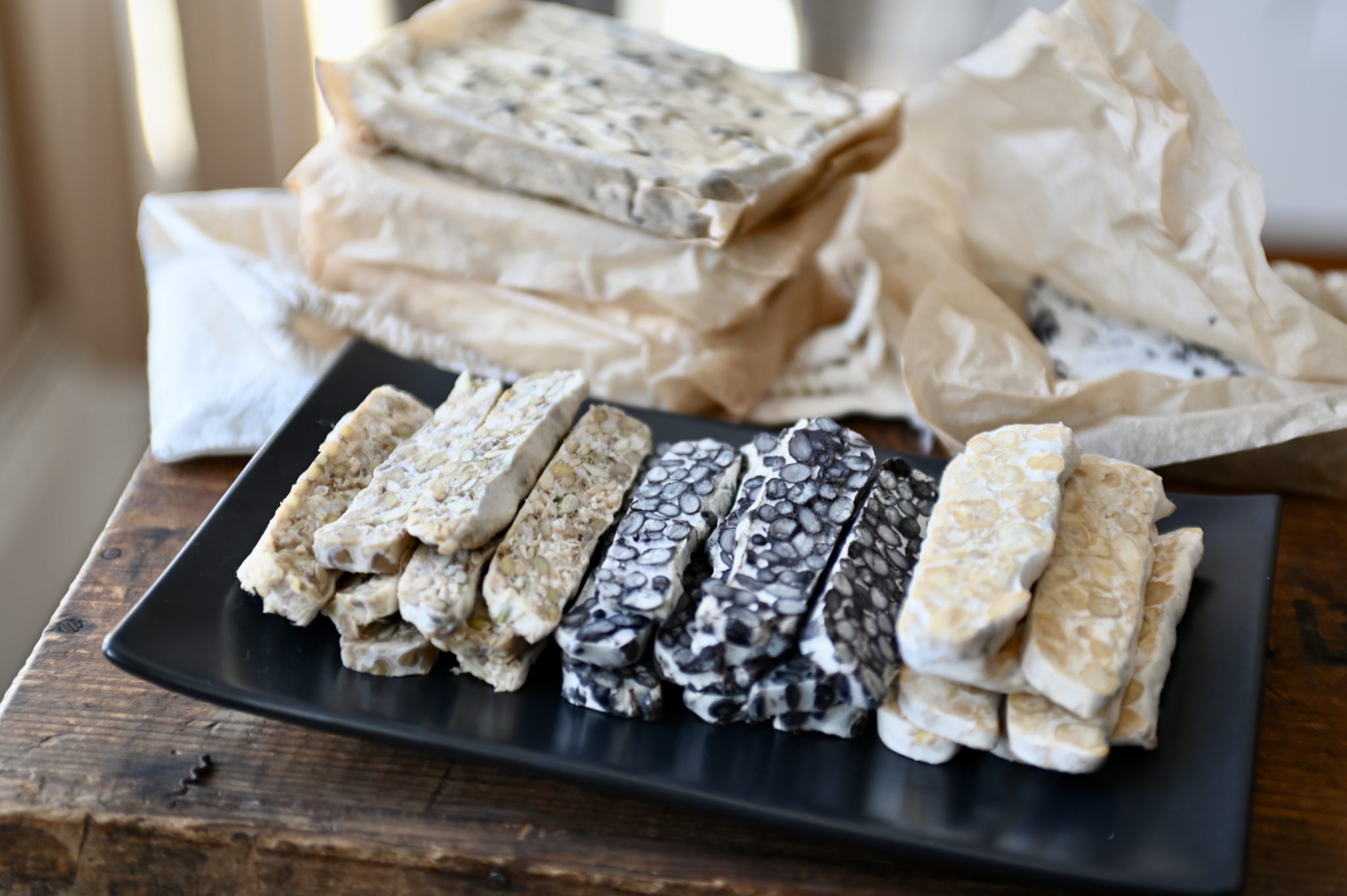
With a practical method & simple equipment, this Homemade Soy-Free Tempeh recipe is perfect. It’s so tasty, healthy, and best of all: no soy or plastic involved!
If you eat a plant-based diet, I’m sure you know tempeh. There are so many kinds of tempeh on the market nowadays, but most commonly its made from soy.
I have no problem eating non-GMO soy, but sometimes, I crave something different such as Homemade Soy-Free Tempeh to get different flavors.
I wanted to make my own tempeh for so long but I got so intimidated by all the equipment they suggested in order to make it at home. Also, when I looked closely into making it, my other big concern was all the plastic used.
All of the tutorials I researched suggest to use plastic bags, or to use banana leaves if I want to make it the way people in Indonesia made it in the past.
Using plastic bags for making food? Nah.
Buying banana leaves that have to be shipped from far away so I can make my own tempeh more environmentally? Umm.. it’s almost good, but. Nah.
So, I avoided making my own tempeh and made homemade sprouted tofu instead. However, sometimes I want to cook something coarser and tofu doesn’t give the same texture like tempeh does.
The problem has turned me back to trying to make my own tempeh again. This time, I was determined. There must be an easier way to make it without buying extra equipment and using plastic bags.
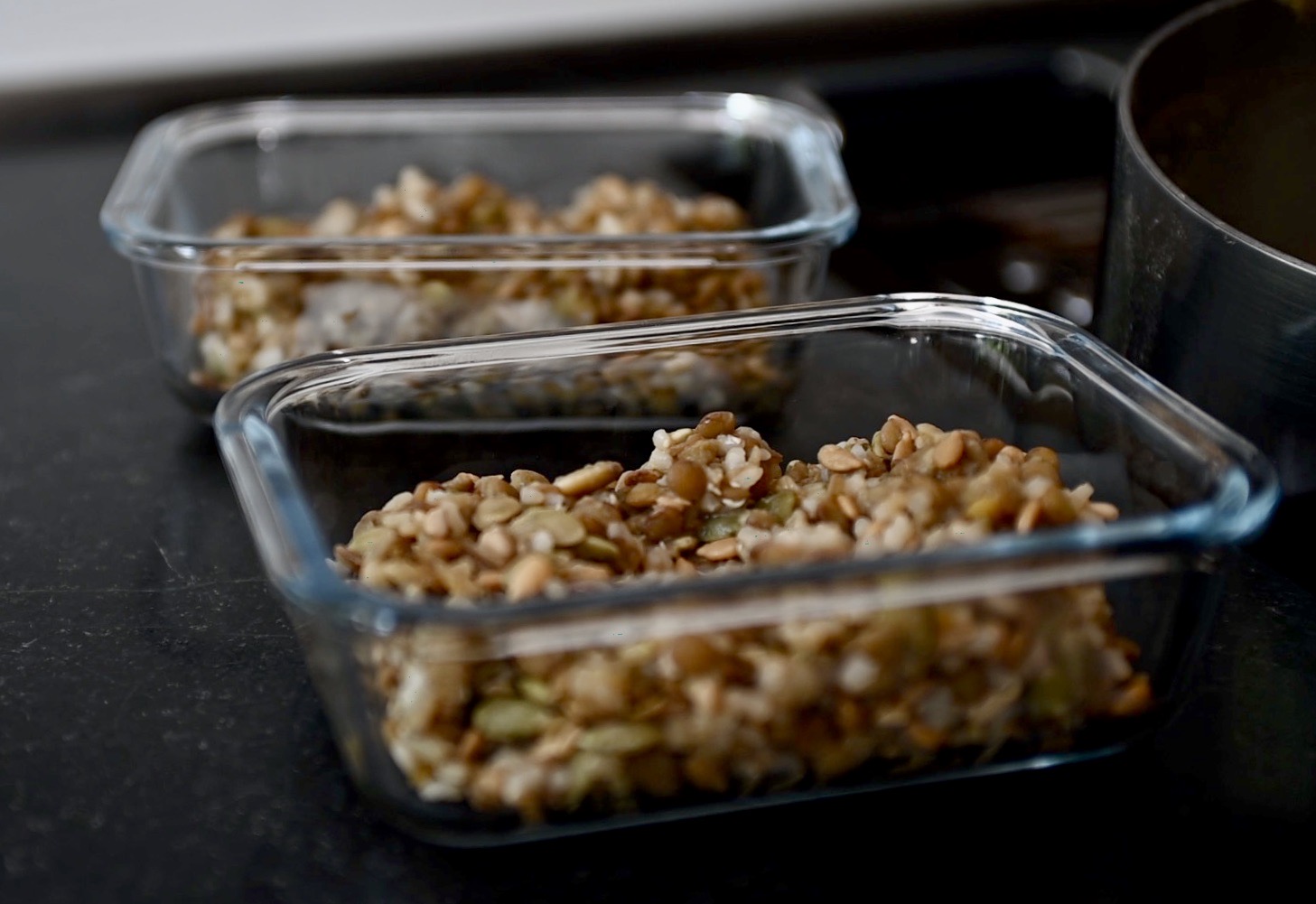
use glass containers instead of plastic bags
I decided to experiment making black bean tempeh first. I used 2 glass containers and a wooden box that I used to put colored pencils in when my daughter was a little girl.
To make the environment for the mold to grow, I use a damp cloth to cover the containers, then closed the lid. I left the box on the dining table where the room temperature is kept at 68 degrees fahrenheit (20° C), and repeat dampening the cloth once everyday.
It was very exciting to see the mold start growing. When it finally finished, the beans were all covered with beautiful, thick white mold. It was hard to believe that it’s not hard at all to make tempeh, and I should have done this years ago.
I cut my first Homemade Soy-Free Tempeh very thin and fried it with a little bit of coconut oil and soy sauce on low heat. It was so tasty that we ate it in one sitting with just a warm bowl of rice–it’s that good!
As I gained more and more confidence, I explored more options using other kinds of beans, seeds and rice. I now know that tempeh can be easily made with other kinds of beans and grains too, but for now I’m happy rotating between these 3 varieties.
Ready to make Homemade Soy-Free Tempeh? Let me show you how!
Ingredients:
Note: you can choose any one of these recipes to make at a time–it is not necessary to make them all at the same time. I just want to show that you can make Homemade Soy-Free Tempeh with all kinds of beans and grains.
For Black Bean Tempeh:
- 1 cup (235 ml) of black beans
- ½ tsp (5 ml) of tempeh culture
- 2 TBSP (30 ml) of apple cider vinegar
For Garbanzo Bean Tempeh
- 1 cup (235 ml) of garbanzo beans.
- ½ tsp (5 ml) of tempeh culture
- 2 TBSP (30 ml) of apple cider vinegar
For Lentil, Rice, Sunflower & Pumpkin Seeds:
- ½ cup (118 ml) of any kind of lentils
- ⅓ cup (45 ml) of short grain brown rice, sunflower seeds, pumpkin seeds
- ½ tsp (5ml) of tempeh culture
- 2 TBSP (30 ml) of apple cider vinegar
Equipment:
- 2 glass containers, the size that I use is about 5” x 7” (4” x 6” at the bottom)
- Any kind a box with a lid at you that you have. I happen to have a wooden box so I use it.
- A cloth or a towel
Instructions:
Note: making tempeh with this method take about 6 days together. However, it only takes a few minutes of work each day.
For Black Bean Tempeh:
- Day 1, sort out any foreinge objects in the beans. Black beans tend to have more of these. Rinse well and soak them overnight.
- Day 2, dump the soaking water, and rinse thoroughly.
- Transfer the beans to a pot and cover them with filtered water.
- Cook on medium heat with a lid covered but leave a small crack. Watch it closely during this time as it can overflow very easily.
- Skim the foam off if you like, then continue to cook it covered. Add more water if needed, turn the heat down a little bit, and continue to cook until they are soft and easily smashed with your fingers. Note: drain the excess water if you have too much left after the beans are soft.
- Let them cool to body temperature, then add vinegar followed by the tempeh starter. Mix thoroughly, and transfer it equally to glass containers. Lightly pack and level off the surface.
- Put the container in a box, cover them with a damp-warm cloth, then loosely close the container’s lid.
- Day 3 until done, dampen the cloth once a day and put it back in–2 times a day is ok too.
- By Day 4, you see some mold start to grow.
- Day 5, it should be covered with more mold. You can stop it at this point, but I like to let the mold to grow thicker for another day.
- Day 6, the beans are all covered with the white mold. Note: You can use it now, but it’s still soft and not easy to cut. It’s better to let it rest in the fridge for another day before using it.
- Take it out of the container. Wrap it with parchment paper, and store it in a cloth bag or breathable container. Let it rest in the fridge for one night before eating it. Reuse the paper if you can.
- After being in the fridge for one night, it gets firmer and easier to cut. Now you can use it with any recipes that require tempeh. It stays fresh for a week.
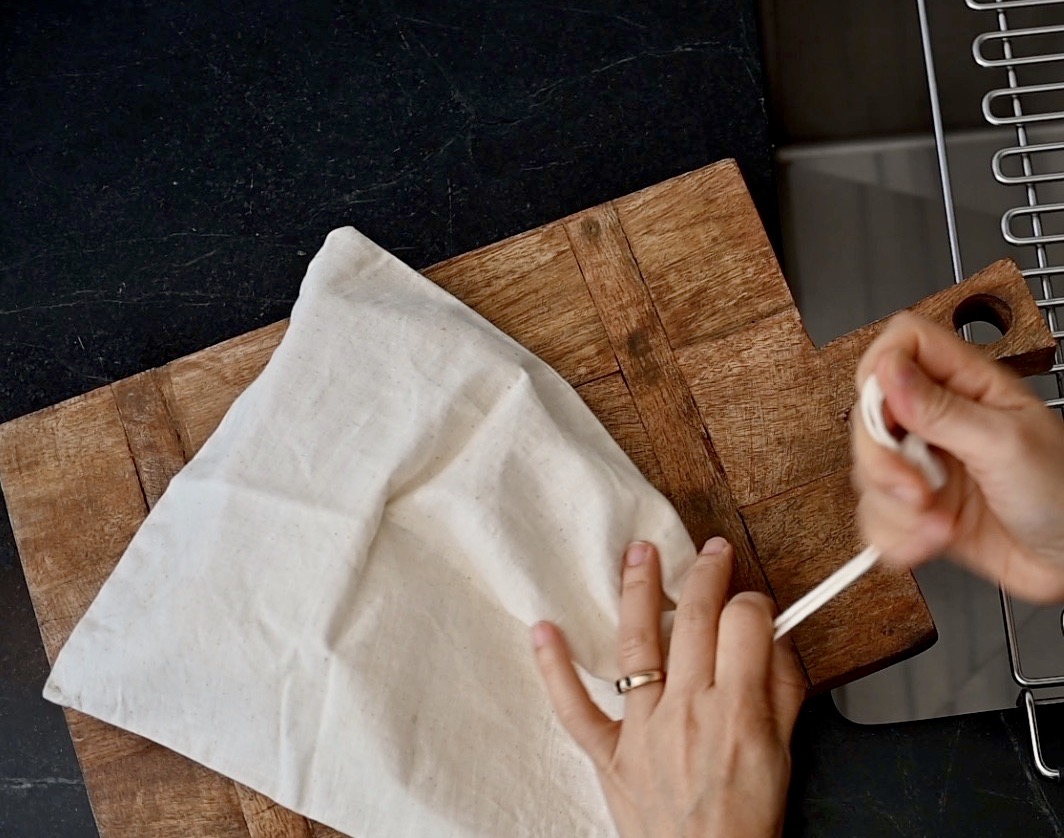
store it in a cloth bag
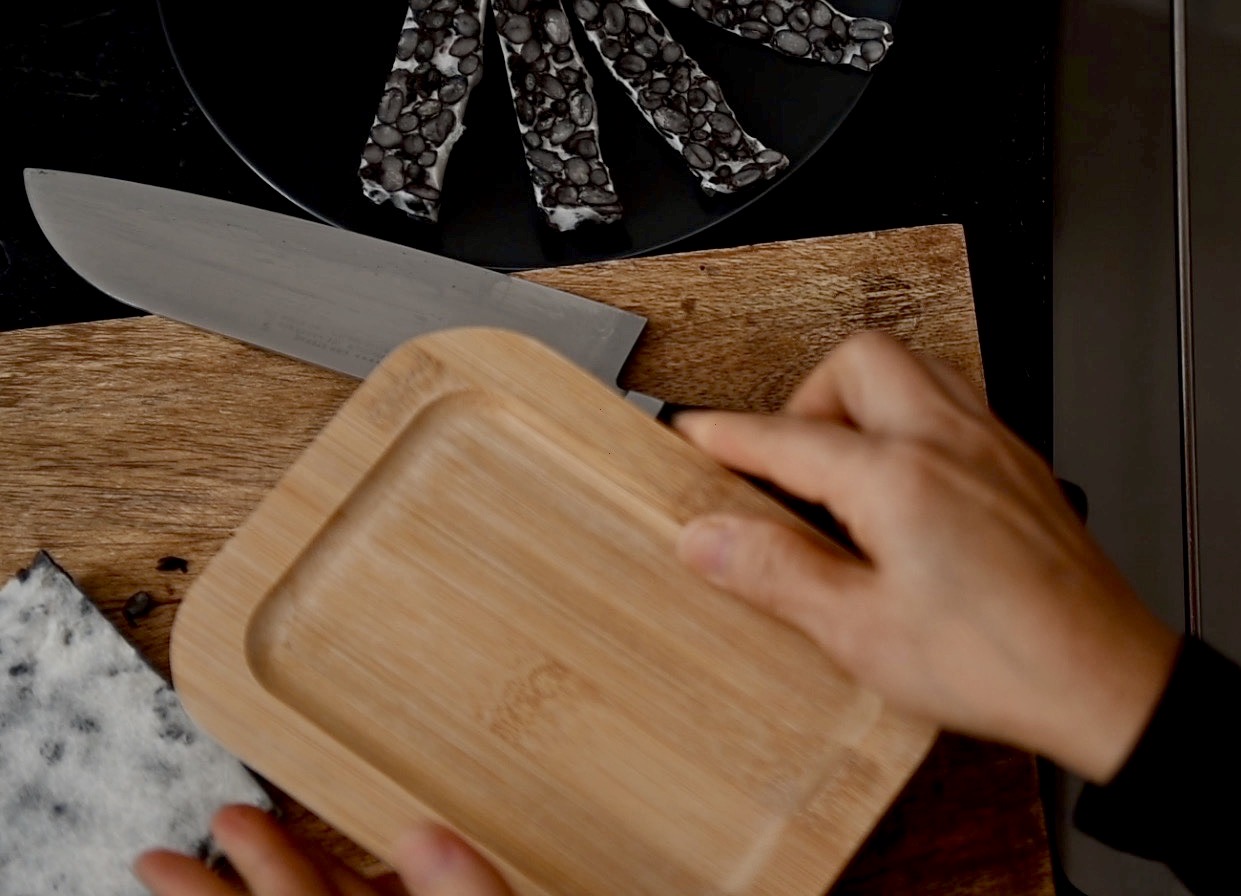
you can simply close the lid if you plan to use it in the next or two
Note: You can keep it in the container with its lid on loosely. Although from my experience, being in the container, it has moisture and it makes it grow unwanted mold and the tempeh goes bad sooner. I noticed that if I wrap it with parchment paper and store it in a cloth bag, it stays dry and lasts longer than a week.
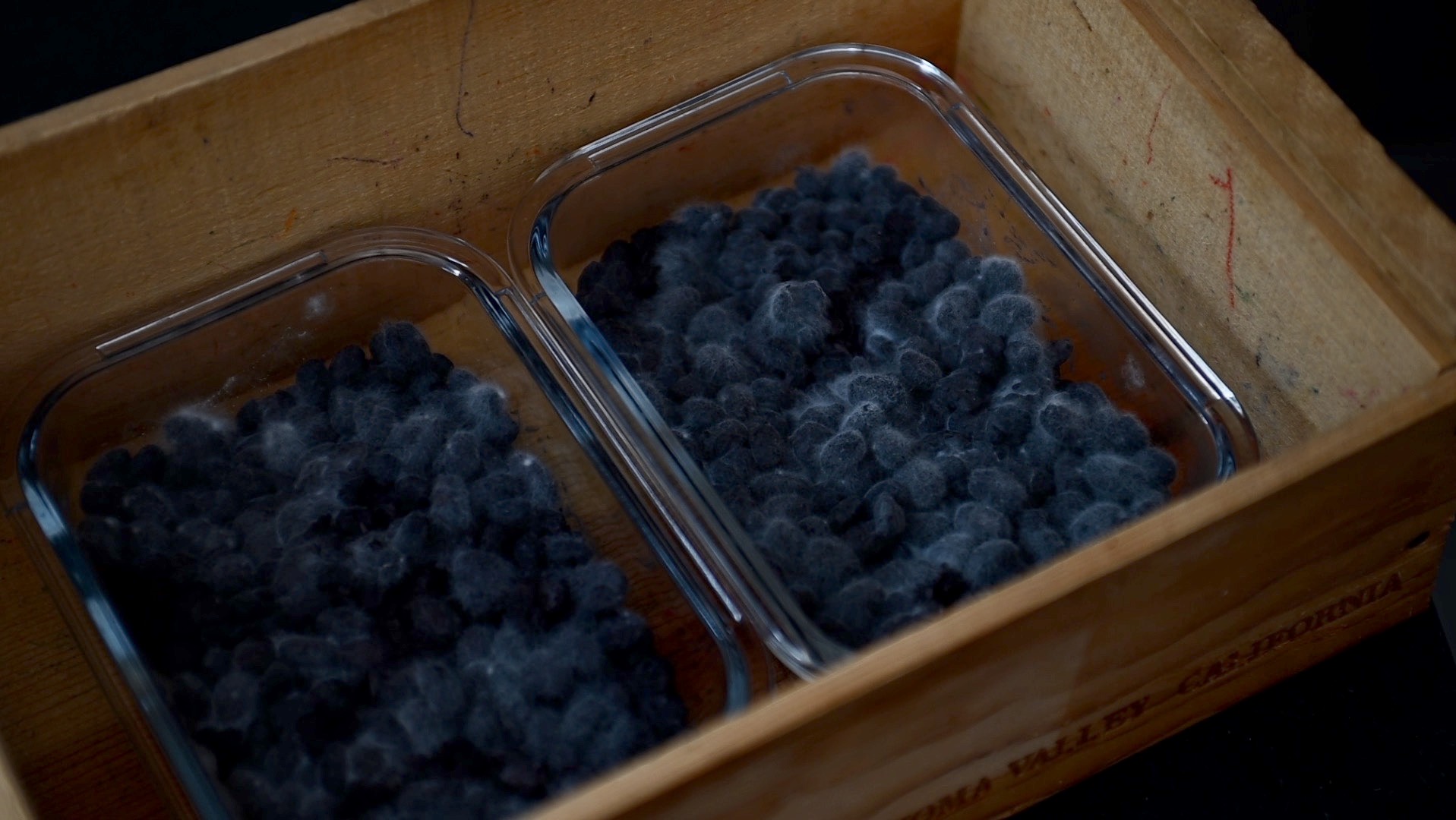
the mold starts to grow
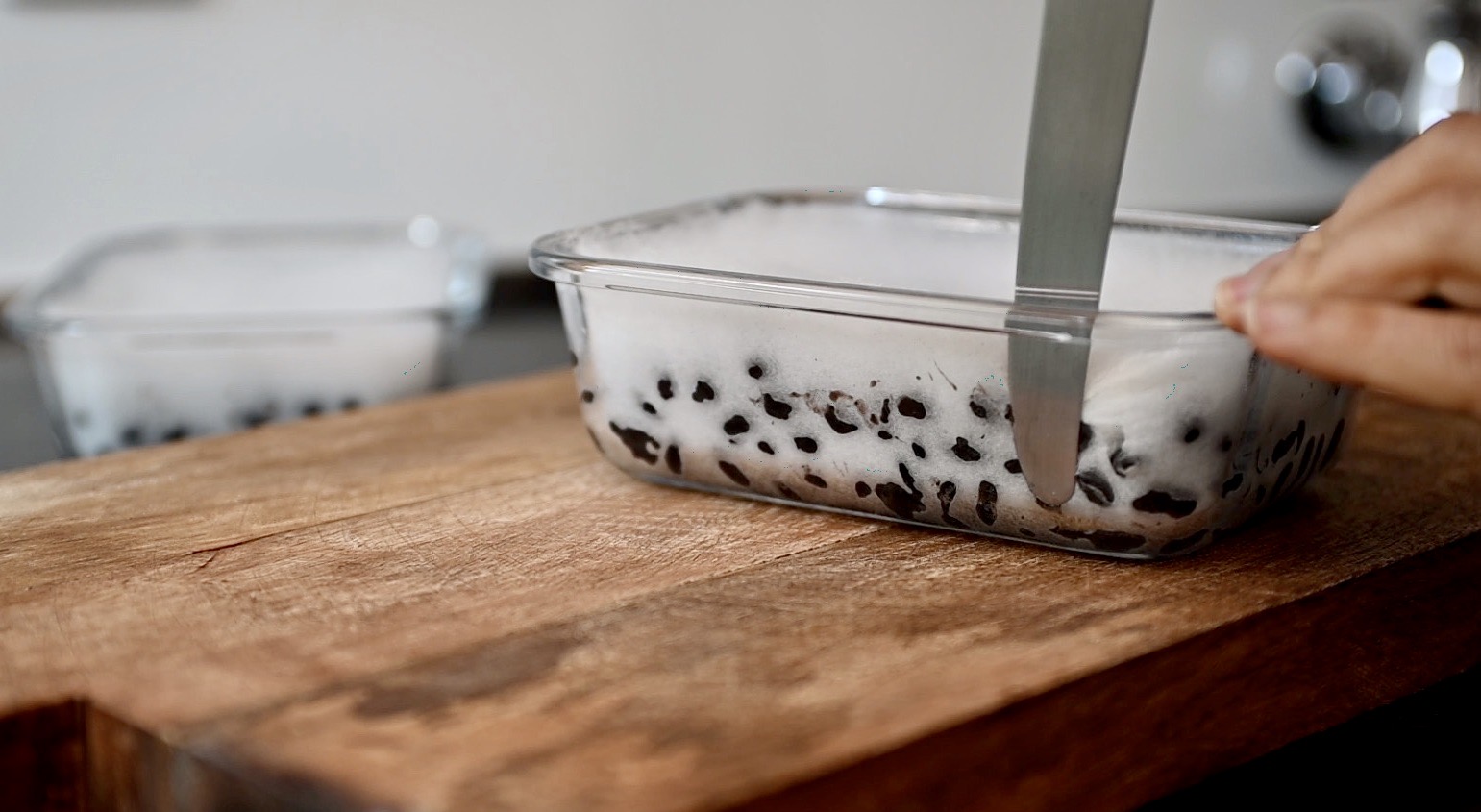
For Garbanzo Bean Tempeh.
- Soak and cook the beans as you do with the black bean tempeh.
- Roughly smash them and let cool before adding the vinegar and the starter
- Repeat and follow the same steps for the black bean tempeh above.
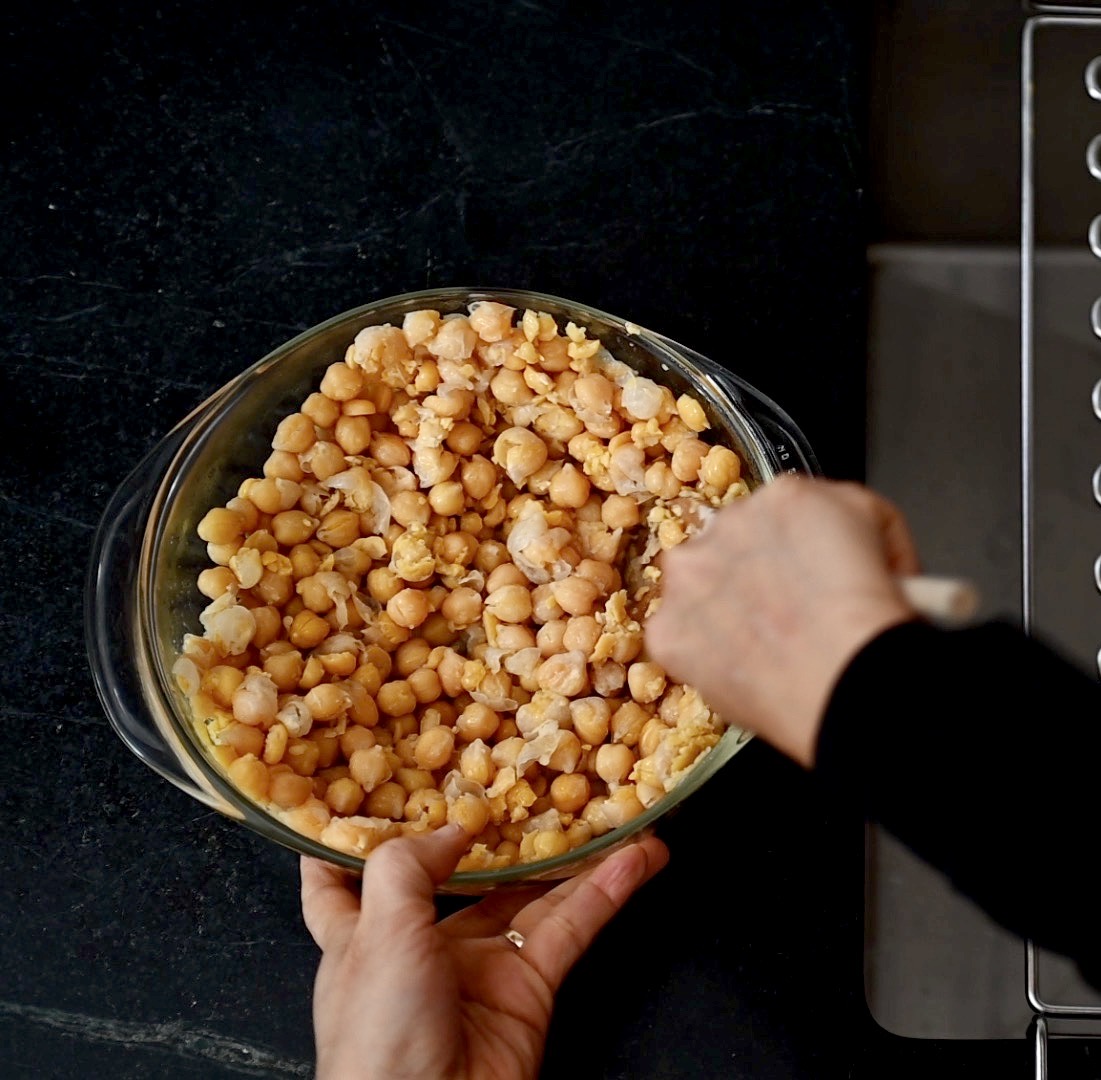
roughly smash the cooked garbanzo beans
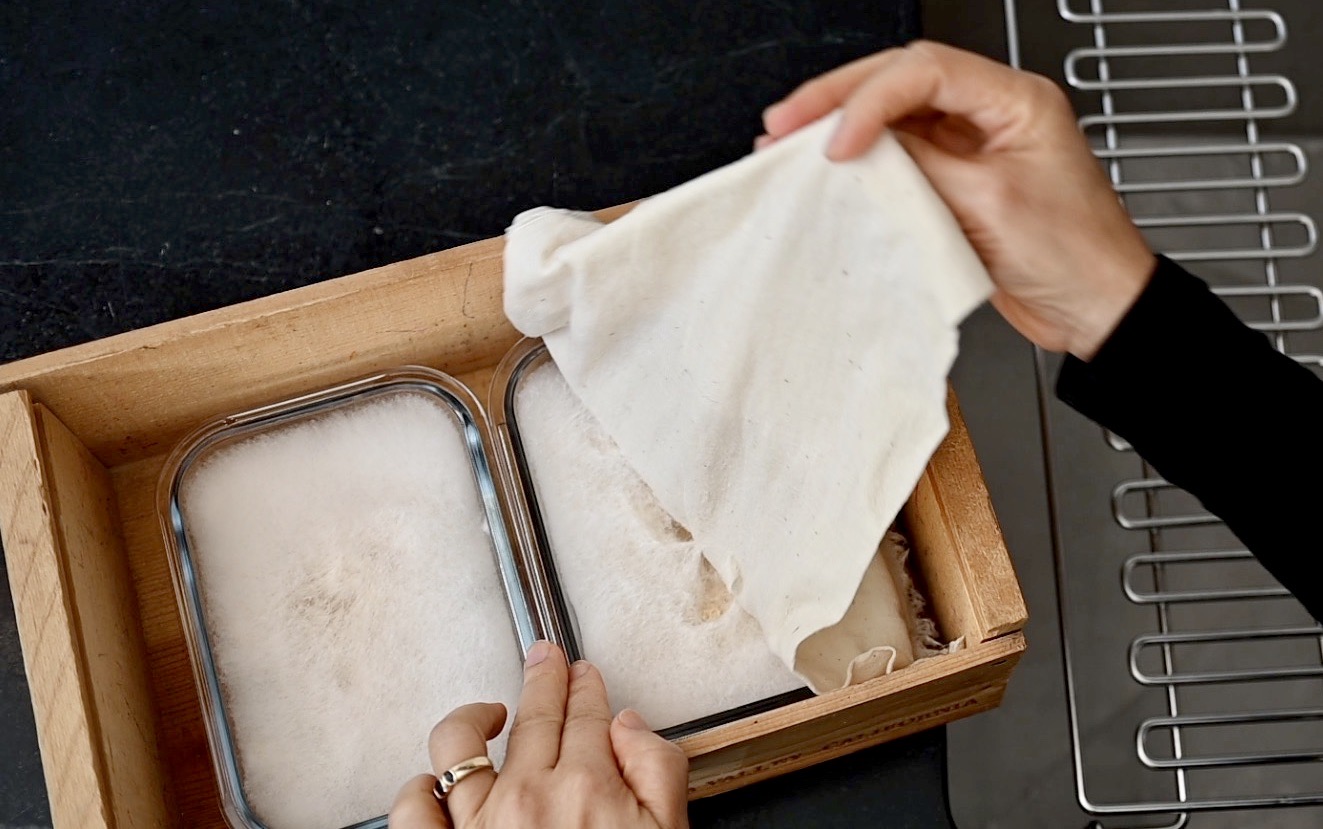
carefully remove the cloth if the grows onto to it
For Lentil, Rice, Sunflower & Pumpkin Seed Tempeh:
- Rinse and soak everything in filtered water overnight.
- Dump the soaking water and cook on medium with filtered water until soft.
- Drain the excess water and let it cool.
- Add the vinegar and the starter, then follow the black bean tempeh instructions above. Note: making this kind of tempeh takes a day longer, so be patient.
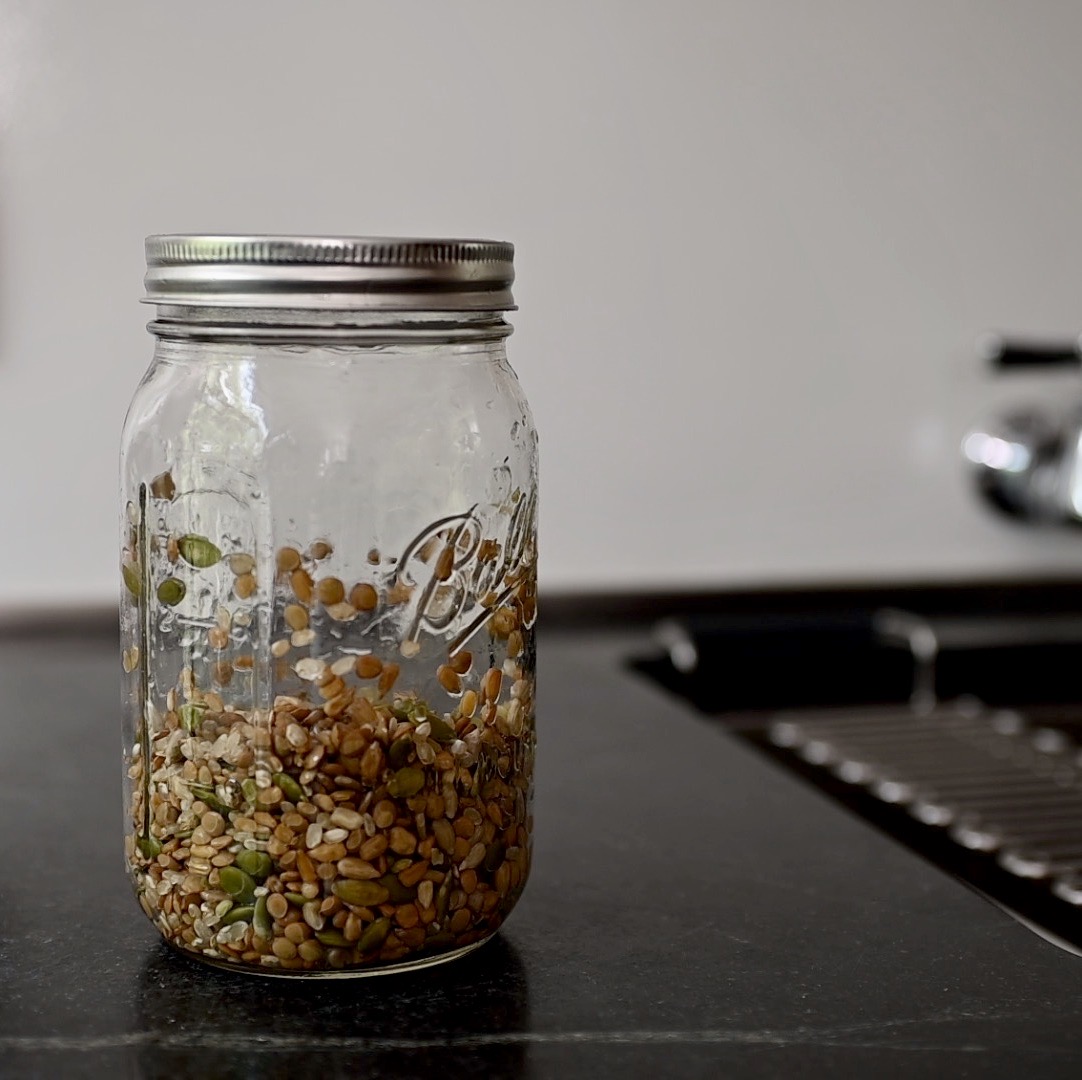
lentil, brown rice, sunflower & pumpkin seeds
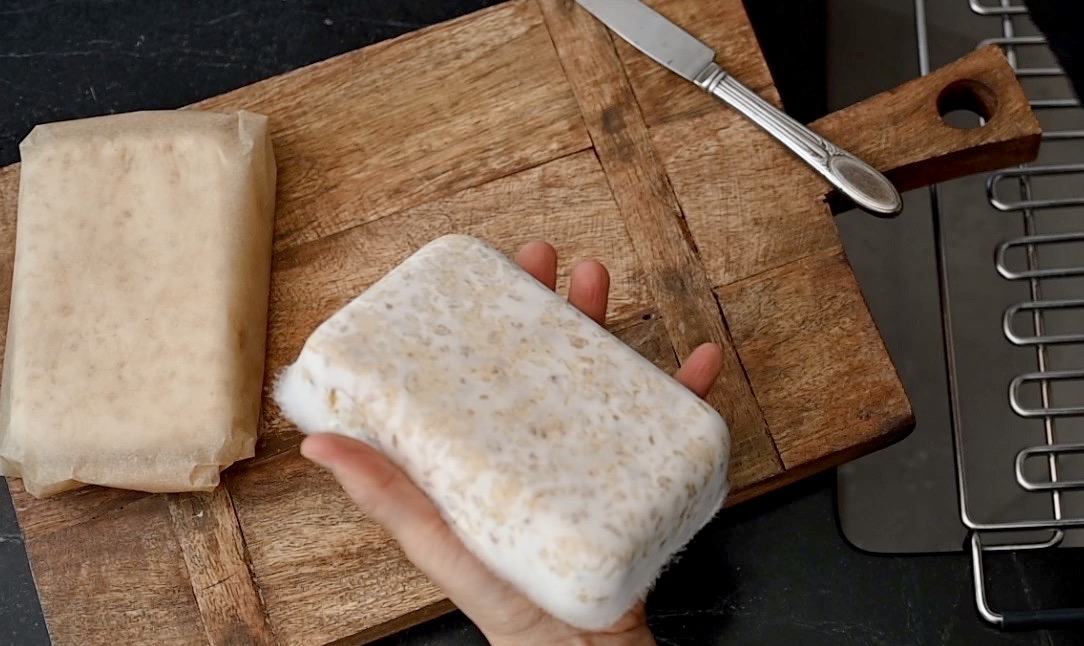
the mold holds the lentil, rice and seeds together
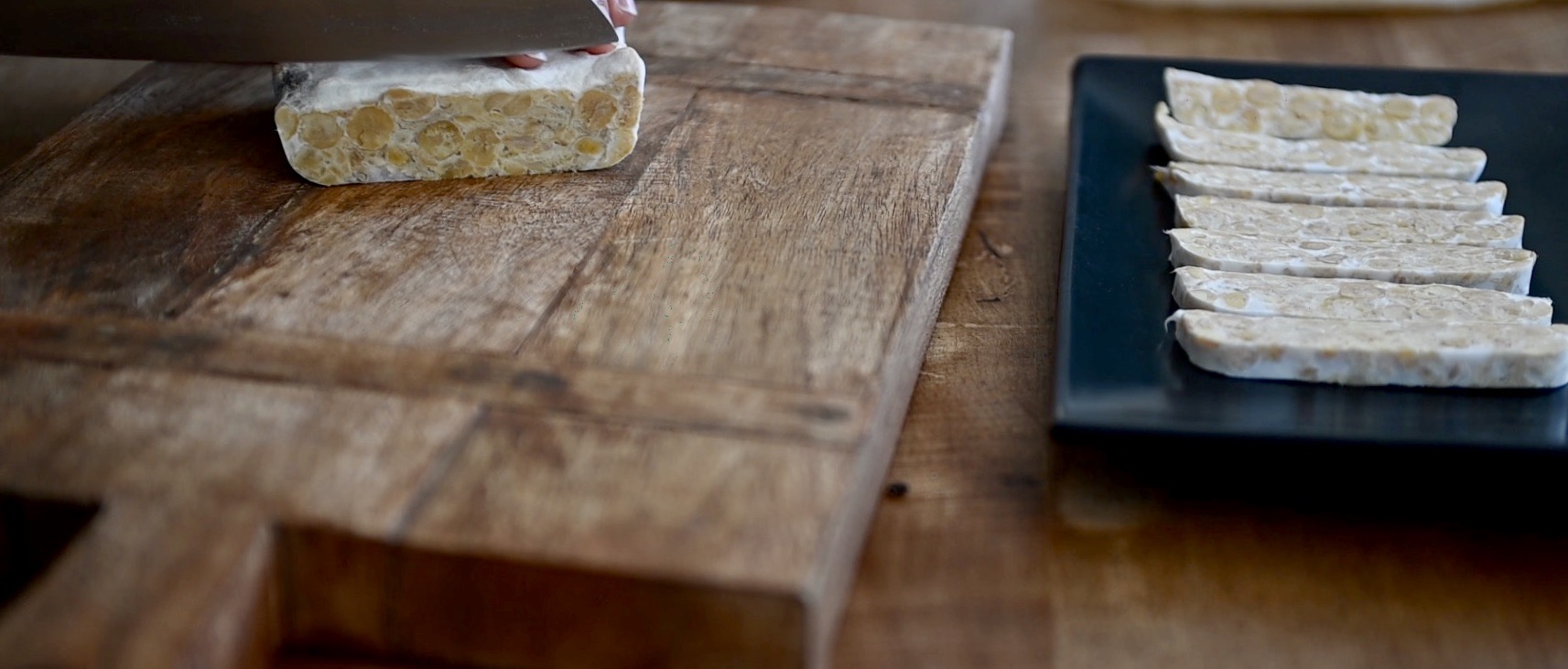
Have you made Homemade Soy-Free Tempeh? Which kind is your favorite? Share it with me below–I’d like to hear about it!
Hello, thank you for such a beautiful variety of soy free options. I was wondering if a cardboard box would be ok?
I have made garbanzo with sesame and black bean with garlic tempehs.I did use plastic bags in my oven, with the pilot for heat. They was molded over in 18 hrs, and i finished them on the counter for another 24 hrs. I like the cloth bag you have and will try that moistened in a covered glass casserole to hold moisture. Still in the oven which stays about 90-95 degrees. After 12-18 hrs the tempeh starts to make it’s own heat, That’s when it’s time to put it on the counter. I think a large casserole should have enough oxygen for the mold to grow. I have also used a sprinkle of flour or starch if the beans are very wet after draining. i am definitely trying the lentil recipe.
Thanx